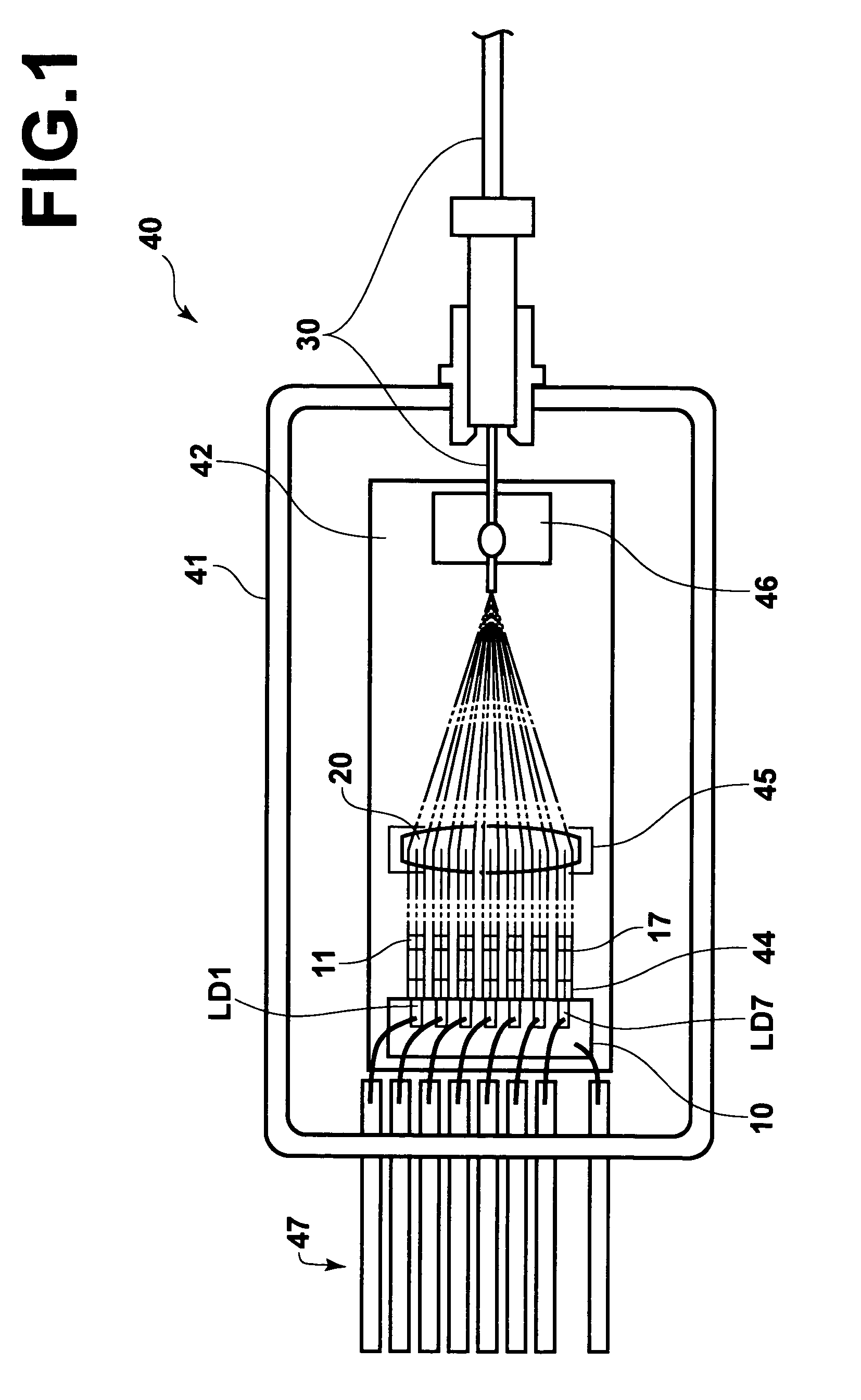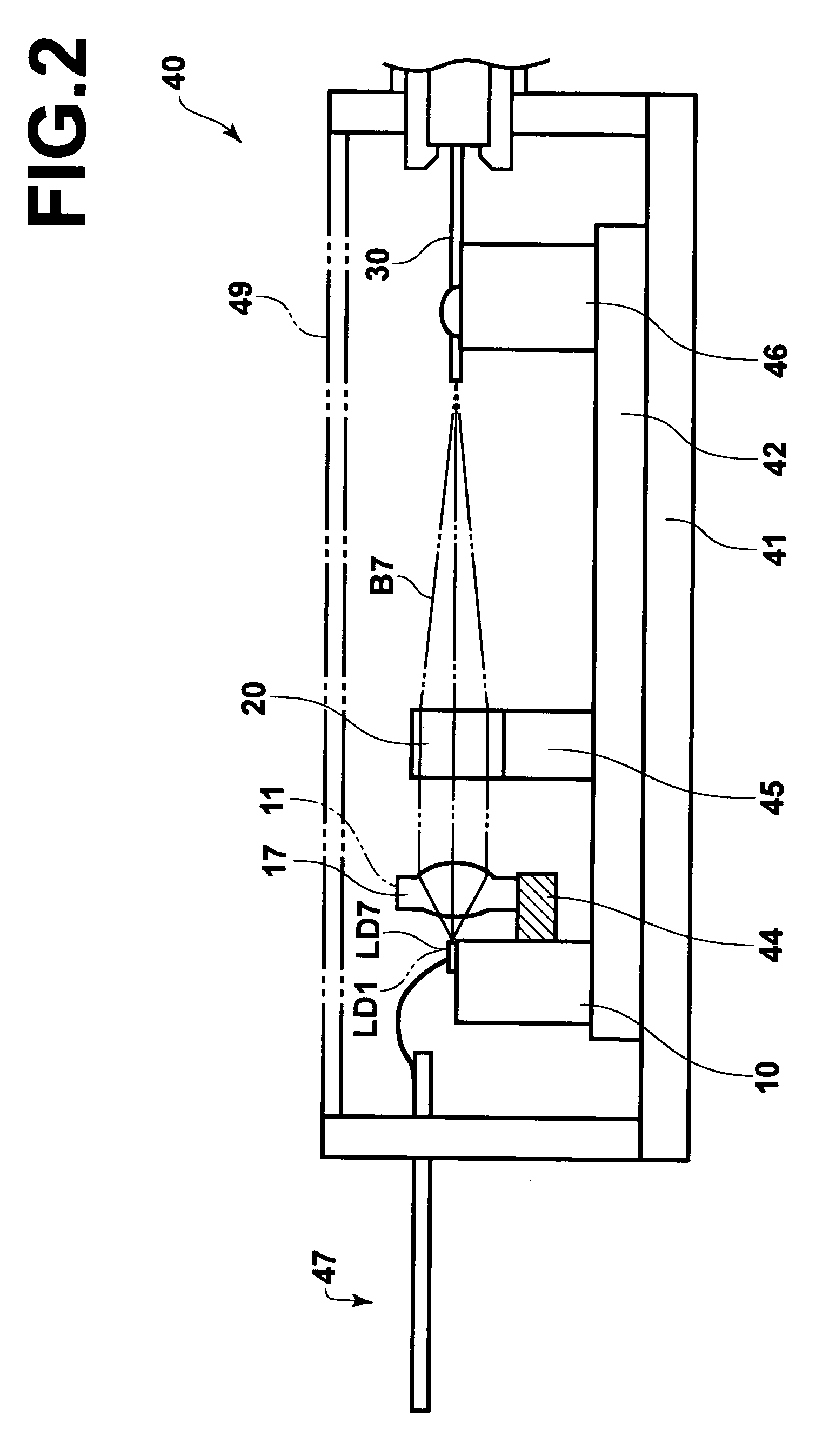Method for adjusting alignment of laser beams in combined-laser-light source where the laser beams are incident on restricted area of light-emission end face of optical fiber
a laser beam and laser beam technology, applied in the field of laser beam alignment, can solve the problems of long time, difficult powering of semiconductor lasers, long time required for gan semiconductor lasers, etc., and achieve the effects of reducing the startup time of combined laser beams, accurate injection of the entire bundle of laser beams, and reducing the number of laser beams
- Summary
- Abstract
- Description
- Claims
- Application Information
AI Technical Summary
Benefits of technology
Problems solved by technology
Method used
Image
Examples
concrete example 1
[0098]As illustrated in FIG. 5A, the combined-laser-light source in the concrete example 1 is constructed in such a manner that the laser beams B1 through B7 are incident on the very small central area E5 in the aforementioned concentric area 30b (having the diameter equal to or smaller than the diameter of the core 30a) when the temperature of the combined-laser-light source is steadily controlled. Since the laser beams B1 through B7 are incident on the identical area, only the single area E5 is illustrated in FIG. 5A.
[0099]FIG. 5B shows the startup characteristic F5 of the above combined-laser-light source. As indicated in FIG. 5B, the output power of the combined-laser-light source enters the rated tolerance range H immediately after the powering on of the semiconductor lasers. That is, even when the semiconductor lasers are powered off and are then powered on, the output of the combined-laser-light source can be used immediately after (e.g., within one second of) the powering on...
concrete example 2
[0100]As illustrated in FIG. 6A, the combined-laser-light source in the concrete example 2 is constructed in such a manner that the laser beams B1 through B7 are incident on the areas E6 in the aforementioned concentric area 30b (having the diameter equal to or smaller than the diameter of the core 30a) when the temperature of the combined-laser-light source is steadily controlled, where the areas E6 are located approximately in the upper half of the concentric area 30b. Since the incident laser beams B1 through B7 are spread, the areas E6 on which the laser beams B1 through B7 are incident are spread as illustrated in FIG. 6A.
[0101]FIG. 6B shows the startup characteristic F6 of the above combined-laser-light source. Similar to the concrete example 1, the output power of the combined-laser-light source enters the rated tolerance range H immediately after the powering on of the semiconductor lasers, as indicated in FIG. 6B. That is, even when the semiconductor lasers are powered off ...
concrete example 3
[0106]As illustrated in FIG. 9A, the combined-laser-light source in the concrete example 3 is constructed in such a manner that the laser beams B1 through B7 are incident on the areas E9 in the aforementioned concentric area 30b (having the diameter equal to or smaller than the diameter of the core 30a) when the temperature of the combined-laser-light source is steadily controlled, where the areas E9 are located approximately in the lower half of the concentric area 30b. Since the incident laser beams B1 through B7 are spread, the areas E9 on which the laser beams B through B7 are incident are spread as illustrated in FIG. 9A.
[0107]FIG. 9B shows the startup characteristic F9 of the above combined-laser-light source. As illustrated in FIG. 9B, the output power of the combined-laser-light source enters the rated tolerance range H immediately after (e.g., within one second of) powering on of the semiconductor lasers. That is, even when the semiconductor lasers are powered off and are t...
PUM
 Login to View More
Login to View More Abstract
Description
Claims
Application Information
 Login to View More
Login to View More - R&D
- Intellectual Property
- Life Sciences
- Materials
- Tech Scout
- Unparalleled Data Quality
- Higher Quality Content
- 60% Fewer Hallucinations
Browse by: Latest US Patents, China's latest patents, Technical Efficacy Thesaurus, Application Domain, Technology Topic, Popular Technical Reports.
© 2025 PatSnap. All rights reserved.Legal|Privacy policy|Modern Slavery Act Transparency Statement|Sitemap|About US| Contact US: help@patsnap.com



